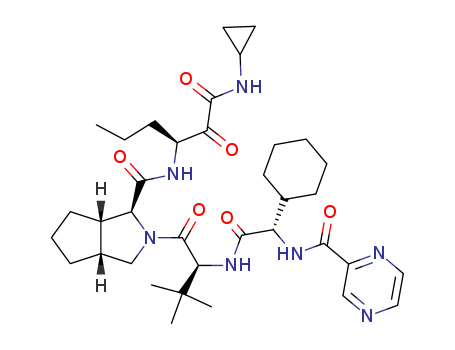Chemical Property of Telaprevir
Edit
Chemical Property:
- Appearance/Colour:White powder
- PKA:11.84±0.20(Predicted)
- PSA:179.56000
- Density:1.25 g/cm3
- LogP:3.94740
- Storage Temp.:Sealed in dry,Store in freezer, under -20°C
- Solubility.:Chloroform, Methanol (Slightly)
- XLogP3:4.2
- Hydrogen Bond Donor Count:4
- Hydrogen Bond Acceptor Count:8
- Rotatable Bond Count:14
- Exact Mass:679.40573244
- Heavy Atom Count:49
- Complexity:1240
- Purity/Quality:
-
99% *data from raw suppliers
Telaprevir *data from reagent suppliers
Safty Information:
- Pictogram(s):
- Hazard Codes:
- Safety Statements:
24/25
- MSDS Files:
-
Useful:
- Drug Classes:Hepatitis C Agents
- Canonical SMILES:CCCC(C(=O)C(=O)NC1CC1)NC(=O)C2C3CCCC3CN2C(=O)C(C(C)(C)C)NC(=O)C(C4CCCCC4)NC(=O)C5=NC=CN=C5
- Isomeric SMILES:CCC[C@@H](C(=O)C(=O)NC1CC1)NC(=O)[C@@H]2[C@H]3CCC[C@H]3CN2C(=O)[C@H](C(C)(C)C)NC(=O)[C@H](C4CCCCC4)NC(=O)C5=NC=CN=C5
- Recent ClinicalTrials:Telaprevir in Genotype 3 HCV
- Recent EU Clinical Trials:Telaprevir in patients with genotype 3 HCV : pilot clinical study to evaluate efficacy and predictability of therapy in patients who have failed to respond to pegylated interferon and ribavirin
- Recent NIPH Clinical Trials:The effect and safety in Telaprevir with combined peginterferon alpha-2b plus ribavirin for chronic hepatitis C patients
-
Description
The hepatitis C virus (HCV) protease inhibitor telaprevir (VX-950, MP-
424,LY-570310) was approved by the U.S. FDA in May 2011 for the treatment
of genotype 1 chronic HCV infection in adult patients in combination with
peginterferon alfa and ribavirin (PR). Telaprevir and boceprevir (vide
supra) are the first two HCV protease inhibitors to be approved for
treatment of HCV infection. Telaprevir is a HCV NS3-4A protease
inhibitor that exerts its antiviral effect by blocking the release of
nonstructural viral proteins from a polyprotein precursor. Telaprevir is a
potent inhibitor of the protease (IC50=10 nM) and is active in cell culture
(HCV 1b replicon assay, EC50=354 nM). Telaprevir was identified from
efforts to truncate a decamer peptide inhibitor derived from the natural
substrate NS5A-5B and was guided by structure-based design. The ketoamide
group of telaprevir forms a covalent, reversible bond with the active
site serine hydroxyl of the protease and compensates for the loss of affinity
resulting from truncation of the peptide. Despite the presence of the reactive keto-amide group, telaprevir is >500-fold less potent against other serine
proteases. Synthesis of the key octahydrocyclopenta[c]pyrrole-1-carboxylic
acid fragment of telaprevir is achieved by a-deprotonation of Boc-protected
3-azabicyclo[3.3.0]nonane followed by reaction with CO2 and resolution of
the racemic acid. Alternatively, deprotonation is carried out in the
presence of a chiral amine to give the enantiomerically enriched acid.
-
Uses
Telaprevir is a peptidomimetic inhibitor of hepatitis C virus protease. Labeled Telaprevir, intended for use as an internal standard for the quantification of Telaprevir by GC- or LC-mass spectrometry. A labelled peptidomimetic inhibitor of hepatitis C virus protease.
-
Clinical Use
Telaprevir is a potent peptide mimetic inhibitor of Hepatitis C
virus (HCV) and works via covalent reversible binding to the
NSV-3A protease enzyme. Telaprevir was discovered and developed
by Vertex pharmaceuticals. The drug is marketed as an oral
treatment for HCV infection in combination with Peg interferon
and ribavarin for patients who are refractory to the initial standard
therapy. The initial SAR studies and the discovery of teleprevir
have been published. In addition, a full review of the discovery
process that led to the development of telaprevir, including
several iterations of the syntheses of teleprevir leading to the process
route, has been reported.
-
Drug interactions
Potentially hazardous interactions with other drugs
Alpha-blockers: avoid with alfuzosin.
Analgesics: risk of ventricular arrhythmias with
methadone.
Anti-arrhythmics: risk of ventricular arrhythmias
with amiodarone and disopyramide - avoid; risk
of ventricular arrhythmias with flecainide andpropafenone - use with caution; use IV lidocaine
with caution.
Antibacterials: concentration of both drugs increased
with clarithromycin, erythromycin and telithromycin,
increased risk of ventricular arrhythmias; avoid with
rifabutin and rifampicin (concentration significantly
reduced by rifampicin).
Anticoagulants: concentration of warfarin possibly
affected; avoid with apixaban; possibly increased
dabigatran concentration.
Antidepressants: possibly increased trazodone
concentration; avoid with St John’s wort.
Antiepileptics: avoid with carbamazepine,
fosphenytoin, phenobarbital, phenytoin and
primidone.
Antifungals: concentration of both drugs possibly
increased with ketoconazole, increased risk
of ventricular arrhythmias; possibly increased
itraconazole concentration; possibly increased
posaconazole concentration - increased risk of
ventricular arrhythmias; possibly altered voriconazole
concentration - increased risk of ventricular
arrhythmias.
Antipsychotics: avoid with pimozide; possibly
increases lurasidone and quetiapine concentration -
avoid.
Antivirals: concentration possibly reduced by
atazanavir; concentration of atazanavir possibly
increased; avoid with darunavir, fosamprenavir and
lopinavir; concentration of daclatasvir and possibly
olaparib increased - reduce daclatasvir and olaparib
dose; concentration reduced by efavirenz - increase
telaprevir dose; concentration possibly reduced
by ritonavir; concentration of tenofovir possibly
increased.
Anxiolytics and hypnotics: possibly increased
midazolam concentration - risk of prolonged
sedation, avoid concomitant use with oral
midazolam.
Beta-blockers: risk of ventricular arrhythmias with
sotalol - avoid.
Ciclosporin: concentration of both drugs increased,
reduce ciclosporin dose.
Cilostazol: possibly increases cilostazol
concentration.
Colchicine: possibly increased risk of colchicine
toxicity - suspend or reduce colchicine dose, avoid in
hepatic or renal impairment.
Cytotoxics: possibly increases bosutinib
concentration - avoid or consider reducing dose of
bosutinib; reduce dose of ruxolitinib. Domperidone: possibly increased risk of ventricular
arrhythmias - avoid.
Ergot alkaloids: avoid concomitant use.
Guanfacine: possibly increases guanfacine dose -
halve dose of guanfacine.
Lipid-regulating drugs: avoid with lomitapide,
simvastatin and atorvastatin.
Oestrogens: possibly reduced ethinylestradiol
concentration and contraceptive effect.
Sildenafil: avoid concomitant use.
Sirolimus: concentration of both drugs increased,
reduce sirolimus dose.
Beta2
sympathomimetics: avoid with salmeterol - risk
of ventricular arrhythmias.
Tacrolimus: concentration of both drugs increased,
reduce tacrolimus dose.
Tadalafil: avoid with high dose tadalafil.
Vardenafil: avoid concomitant use.





